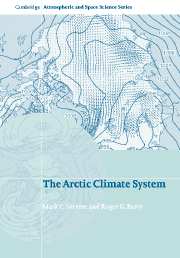Book contents
- Frontmatter
- Contents
- Preface page
- Acknowledgements
- List of Abbreviations
- 1 The evolution of knowledge about the Arctic and its climate
- 2 Physical characteristics and basic climatic features
- 3 The basic atmospheric heat budget
- 4 The atmospheric circulation
- 5 The surface energy budget
- 6 Precipitation, net precipitation and river discharge
- 7 Arctic ocean–sea ice–climate interactions
- 8 Climate regimes of the arctic
- 9 Modeling the arctic climate system
- 10 Arctic paleoclimates
- 11 Recent climate variability, trends and the future
- References
- List of selected websites
- Index
- Plate Section
4 - The atmospheric circulation
Published online by Cambridge University Press: 10 August 2009
- Frontmatter
- Contents
- Preface page
- Acknowledgements
- List of Abbreviations
- 1 The evolution of knowledge about the Arctic and its climate
- 2 Physical characteristics and basic climatic features
- 3 The basic atmospheric heat budget
- 4 The atmospheric circulation
- 5 The surface energy budget
- 6 Precipitation, net precipitation and river discharge
- 7 Arctic ocean–sea ice–climate interactions
- 8 Climate regimes of the arctic
- 9 Modeling the arctic climate system
- 10 Arctic paleoclimates
- 11 Recent climate variability, trends and the future
- References
- List of selected websites
- Index
- Plate Section
Summary
Overview
Some aspects of the atmospheric circulation were introduced in Chapters 2 and 3. The present chapter begins by providing a historical perspective. We then make extensive use of data from the NCEP/NCAR reanalysis to provide a “top down” perspective, starting with the stratosphere and moving to the tropopause, troposphere and the surface. The focus is largely on the mean state, aspects of seasonality and key interactions – temporal variability and trends will be examined largely in Chapter 11. Topics introduced here help set the stage for understanding the surface energy and hydrologic budgets in Chapters 5 and 6.
The stratospheric circulation during winter is dominated by a strong polar vortex; along its margin is the polar night jet. The polar night jet decays through spring, to be replaced in summer by a weak circum-Arctic easterly flow. The winter vortex sometimes rapidly breaks down due to sudden stratospheric warmings, the effects of which can impact the troposphere and surface. At 500 hPa, a circumpolar vortex is present year-round. It is strongly asymmetric during winter, with major troughs over eastern North America and eastern Asia and a weaker trough over western Asia. A prominent ridge is located over western North America. The lowest winter pressure heights at 500 hPa are found over the Canadian Arctic Archipelago. This asymmetry is related to orography, large-scale land–ocean distributions and radiative forcing. The mid-tropospheric vortex weakens during spring and summer and becomes more symmetric than its winter counterpart.
Information
- Type
- Chapter
- Information
- The Arctic Climate System , pp. 74 - 109Publisher: Cambridge University PressPrint publication year: 2005
